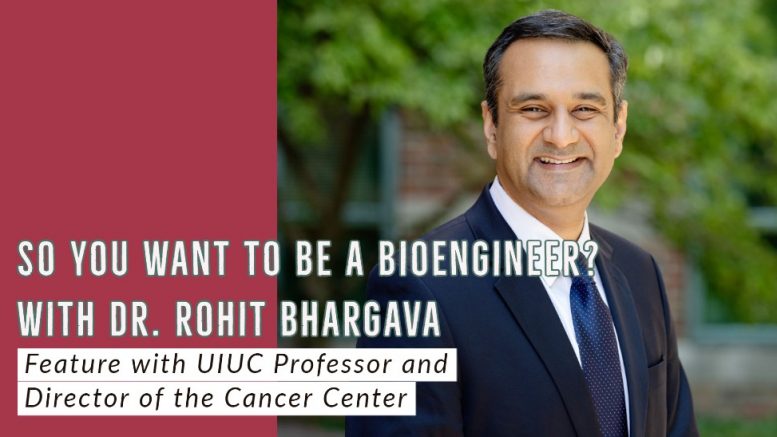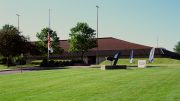A special thanks to Dr. Rohit Bhargava for sitting down with me to have this conversation. Thanks for sharing your time, wisdom, and experience!
Bioengineering is a budding field that is attracting students across the nation. Enabling students to embrace biology as a new engineering paradigm, bioengineering makes it possible to apply engineering principles to medical problems and biological systems. Especially with an increasing demand for creative solutions in the medical and biological fields, a bioengineering education can provide an interdisciplinary perspective to potential pre-health students or any students looking for careers in research. While biomedical engineering and bioengineering often evoke images of prosthetics and 3D printed organs, there’s a lot more to the field as I found from my conversation with Dr. Rohit Bhargava. To learn more about Dr. Bhargava, check out this link: https://news.illinois.edu/view/6367/807810
Dr. Bhargava sat down with me to discuss how he found his way to a career in bioengineering, what he’s done so far, and what advice he can give to those of us who find a future in the field fascinating.
Education, Fellowship, and Job Search
Dr. Bhargava noted that he thought that “Some of the instincts for engineering start early in how you play and what kind of things you might be interested in.” As someone always interested in the kinds of things where you make something right with your hands, he expressed that he felt as if he had “fell into engineering mostly by chance.” In India, where you couldn’t get into college by just applying, he took the universal entrance exam that, generally, for higher achieving students with good entrance exam scores, lead to one of two careers: engineering or medicine. Dr. Bhargava, as a high achieving student who was “fascinated by molecular things,” thought that chemical engineering would be an ideal career path. Upon his graduation, he got a Ph.D. here at Case Western Reserve University in Cleveland and then completed a five-year fellowship at the NIH. At that point, UIUC was starting a new bioengineering department. As somebody who likes to build things, Dr. Bhargava was “excited that [he] could go in and get in on the early stages of trying to build a department of bioengineering.”
Projects
IR Spectroscopy
Dr. Bhargava was part of the effort to develop chemical imaging, as one of the pioneers of infrared spectroscopy which allowed people to “visualize the chemical composition of materials as opposed to just looking at their shape or structure.” He’s still involved in that research to this day.
His motivation behind this research?
They have amazing applications: “One of the motivating things for us to involve ourselves in chemical imaging was the idea of understanding how cancers grow, specifically looking at the microenvironment of cancers,” he said. “You can’t observe cancer growing in a human, right? That’s not ethical. So there is a need to create those kinds of systems in the lab. So we developed a 3D printer and now, we’re developing techniques to basically grow tumors in the lab…it’s all to try to understand how cancers are influenced by their environment and can grow.”
Founding The UIUC Cancer Center
When asked about why he thought to found the cancer center with a focus on technology, Dr. Bhargava responded, “When you think of some big problems to solve across the world, cancer is a pretty devastating one. There aren’t too many good ways to deal with it. So about a few years ago, we thought that maybe cancer is not just a medical problem but thought of it as a technology problem. If we could invent better technology, we could do a better job in dealing with all aspects of cancer. Whether it’s a diagnosis or having better drugs, how do you discover better things? In all aspects, technology has changed our life, our everyday lives, so maybe it could change the way we think about cancer.”At the time that he came into the field, it was a pretty radical thought to consider engineering and technology going into a health space, considering that they had primarily been thought of as a way of making things better or reducing costs. However, he explained that it is “the need of the day: reducing health care costs and giving better health care, whether it’s COVID, cancer or anything else.”
Breast Cancer Research
In a study attempting to find what factors drive breast cancer, Dr. Bhargava investigated how cancers grow. He explained that “for a long, long time, people have focused on looking at the cancer cells themselves. And the cancer cells, of course, are really interesting and have a lot of information that helps us understand cancer and understand why it grows. More and more people are now starting to realize that the microenvironment, the region around the cancer of the environment, around cancer, can help grow it or help retarded it.” This particular study was an attempt to find what kind of markers could be used to look at in the noncancerous part of the tissue that allows cancer to grow or not. “The microenvironment offers a more complete picture,” he described. “So imagine if you were trying to assess the quality of something in isolation. It’s as if I gave you one sentence from a paragraph and said, how’s the writing, you know? You might be able to make some sense of it, but if I gave you the whole essay and say, how does this line fit into the central theme of the essay, it’s much more informative. That’s essentially it. We’re trying to characterize, in addition to the tumor, the role of the microenvironment. If we can identify some important factors, it gives us fantastic context to try and understand it better.”
His Most Meaningful Work
When I asked if among all of his work, if there was something he was particularly proud of, he humbly responded saying that, “I wouldn’t say proud. I would say grateful. I’m grateful for all the awards that come our way. But, it’s not so much the awards because they are a natural consequence of what you’re doing. You can’t really control the recognition, but you can certainly control the quality of work that you do. And we do believe in doing original things, things that truly matter.”
He noted that one of his most interesting projects was we worked with one of our students a few years ago. He noted that “the whole imaging community was stuck at a certain point.” He was part of a project that built an instrument that showed tremendous promise to improve imaging with an “improvement in quality that people didn’t think was possible.”Now that research is incorporated in commercial products and Dr. Bhargava noted that it’s “one of the particularly satisfying ones, I think because people are using it every day. Now, what seemed, before that work, what seemed impossible is routine.”
Disadvantages in the Workplace
When I asked Dr. Bhargava if had ever felt disadvantaged during his career and he said not at the time elaborating that, “Looking back in hindsight, some things could have been better.” Despite his focus and dedication to his work, there were times that he was passed over for opportunities.
“Now we’re all much more aware of socioeconomic differences and how that might lead to bias. I think when I was in school and college and graduate school, you focused on the work. You didn’t really think too much about these things. But now as one of the senior faculty members here, I’m very conscious that an environment should be created for everyone that values what they have to contribute rather than who they are, so to speak. What I can and I try to do very frequently is make sure that now, for people who are coming up, they all get opportunities that are equal and not different because of who they are.” Dr. Bhargava plays an active role as a professor facilitating an equitous environment for his students to make sure that they aren’t affected by bias in the ways he might have been. If more professors were active, in their inclusionary efforts like Dr. Bhargava, perhaps we could create a more equal world, not only higher education, but also the workplace and by extension, society.
Notes About Being a Bioengineer
Dr. Bhargava finds that engineering is “a way of thinking for sure, but it’s also a way of thinking of solutions. That’s the fun part: when you can see and identify a problem, and come up with a solution. That solution often requires some creativity, some knowledge, and some ability to get the job done. And at the end of the day, it’s very satisfying because you often solve problems.”
Qualities of Engineers
He explained that “Most certainly in today’s day and age, persistence counts. If you believe in something, you’ve got to stick with it and get things done. Hard work, of course, goes without saying, is needed to achieve something. You have to be willing to put in the effort. I think to some degree how much you educate yourself, how hard you’ve worked on the sort of fundamentals and foundations that you’re building on, eventually shows up. If you have a weak foundation, whatever you build, it doesn’t really stand.” He also notes that it’s really important to work together with other people because many of the big problems are too hard to solve all by yourself.
What is it actually like?
Dr. Bhargava spends a lot of his time dealing with and solving problems that are encountered by those who work in his team. His meetings are usually dictated by the problems, decisions, actions, or plans that are brought forward by those who are in his team, both in the cancer center and in his research group. At the moment that means most of his time goes toward working with other people. Though he says it can still be a stimulating experience because they diverge into a lot of “reading and writing, and writing to me is not divorced from the idea of thinking.”
Moreover, he explains that meetings are quite important, because “It’s more than a meeting. It’s an interaction with your team to solve problems or to plan. I try to engage all these things, as many of these as I can at the same time. When you’re reading, you can also think. When you’re writing, you plan. And when you’re meeting, you, of course, engage many other things.”
Advice and Future of Bioengineering
He started by saying, “I think we’re living in really exciting times. You know, on one hand, computing is rising and it’s so easy to communicate and analyze data. So the rise of computing and A.I. as one trend is really great. The second trend that’s actually accelerating now is this idea of precision manufacturing or on-demand manufacturing.” He went on to explain how you could think of making anything virtually today and you can make it right away. Furthermore, he notes that analysis tools, our observation tools, have become much better. He says, “A good microscope now allows you to see things much better than ever before. Or the ability to capture pictures with your phone that are more high-quality photographs than, you know, professional cameras of just a few years ago. I think the ability to measure, the ability to model, and the ability to make are three key ingredients right now. Those three things will continue to grow into many creative solutions.” He anticipates that those three trends will support pretty much every sector, every activity of ours, whether it’s cars, food, or anything else.
To all of us who want to pursue bioengineering, he recommends that we need to follow our interests and try to gain opportunities. He says, “Don’t be afraid to ask people right to help out or what you need and you’ll find that many people turn up to help out. You’ll be surprised by how helpful people are more often than you would be surprised by how they’re not. Not everybody, of course, would be helpful. But by and large, most people will be. So continue to pursue what you think you find exciting. I wish you good luck and I hope you come to Illinois!”






Be the first to comment on "So you want to be a bioengineer? Feature with UIUC Professor Dr. Rohit Bhargava, Ph.D."